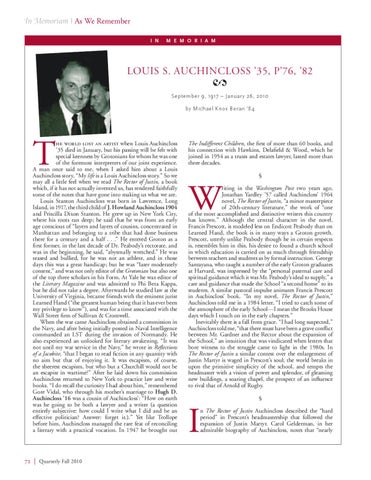In Memoriam | As We Remember I N
M E M O R I A M
Louis S. Auchincloss ’35, P’76, ’82
1 September 9, 1917 – January 26, 2010 by Michael Knox Beran ’84
T
he world lost an artist when Louis Auchincloss ’35 died in January, but his passing will be felt with special keenness by Grotonians for whom he was one of the foremost interpreters of our joint experience. A man once said to me, when I asked him about a Louis Auchincloss story, “My life is a Louis Auchincloss story.” So we may all a little feel when we read The Rector of Justin, a book which, if it has not actually invented us, has rendered faithfully some of the notes that have gone into making us what we are. Louis Stanton Auchincloss was born in Lawrence, Long Island, in 1917, the third child of J. Howland Auchincloss 1904 and Priscilla Dixon Stanton. He grew up in New York City, where his roots ran deep; he said that he was from an early age conscious of “layers and layers of cousins, concentrated in Manhattan and belonging to a tribe that had done business there for a century and a half . . .” He entered Groton as a first former, in the last decade of Dr. Peabody’s rectorate, and was in the beginning, he said, “abysmally wretched.” He was teased and bullied, for he was not an athlete, and in those days this was a great handicap; but he was “later moderately content,” and was not only editor of the Grotonian but also one of the top three scholars in his Form. At Yale he was editor of the Literary Magazine and was admitted to Phi Beta Kappa, but he did not take a degree. Afterwards he studied law at the University of Virginia, became friends with the eminent jurist Learned Hand (“the greatest human being that it has ever been my privilege to know”), and was for a time associated with the Wall Street firm of Sullivan & Cromwell. When the war came Auchincloss obtained a commission in the Navy, and after being initially posted in Naval Intelligence commanded an LST during the invasion of Normandy. He also experienced an unlooked for literary awakening. “It was not until my war service in the Navy,” he wrote in Reflections of a Jacobite, “that I began to read fiction in any quantity with no aim but that of enjoying it. It was escapism, of course, the sheerest escapism, but who but a Churchill would not be an escapist in wartime?” After he laid down his commission Auchincloss returned to New York to practice law and write books. “I do recall the curiosity I had about him,” remembered Gore Vidal, who through his mother’s marriage to Hugh D. Auchincloss ’16 was a cousin of Auchincloss’: “How on earth was he going to be both a lawyer and a writer (a question entirely subjective: how could I write what I did and be an effective politician? Answer: forget it.).” Yet like Trollope before him, Auchincloss managed the rare feat of reconciling a literary with a practical vocation. In 1947 he brought out
72 | Quarterly Fall 2010
The Indifferent Children, the first of more than 60 books, and his connection with Hawkins, Delafield & Wood, which he joined in 1954 as a trusts and estates lawyer, lasted more than three decades. §
W
riting in the Washington Post two years ago, Jonathan Yardley ’57 called Auchincloss’ 1964 novel, The Rector of Justin, “a minor masterpiece of 20th-century literature,” the work of “one of the most accomplished and distinctive writers this country has known.” Although the central character in the novel, Francis Prescott, is modeled less on Endicott Peabody than on Learned Hand, the book is in many ways a Groton growth. Prescott, utterly unlike Peabody though he in certain respects is, resembles him in this, his desire to found a church school in which education is carried on as much through friendship between teachers and students as by formal instruction. George Santayana, who taught a number of the early Groton graduates at Harvard, was impressed by the “personal paternal care and spiritual guidance which it was Mr. Peabody’s ideal to supply,” a care and guidance that made the School “a second home” to its students. A similar pastoral impulse animates Francis Prescott in Auchincloss’ book. “In my novel, The Rector of Justin,” Auchincloss told me in a 1984 letter, “I tried to catch some of the atmosphere of the early School—I mean the Brooks House days which I touch on in the early chapters.” Inevitably there is a fall from grace. “I had long suspected,” Auchincloss told me, “that there must have been a grave conflict between Mr. Gardner and the Rector about the expansion of the School,” an intuition that was vindicated when letters that bore witness to the struggle came to light in the 1980s. In The Rector of Justin a similar contest over the enlargement of Justin Martyr is waged in Prescott’s soul; the world breaks in upon the primitive simplicity of the school, and tempts the headmaster with a vision of power and splendor, of gleaming new buildings, a soaring chapel, the prospect of an influence to rival that of Arnold of Rugby. §
I
n The Rector of Justin Auchincloss described the “hard period” in Prescott’s headmastership that followed the expansion of Justin Martyr. Carol Gelderman, in her admirable biography of Auchincloss, notes that “nearly
